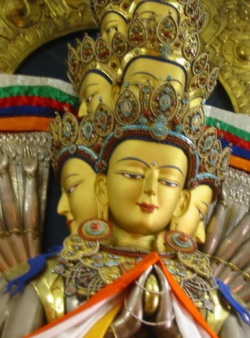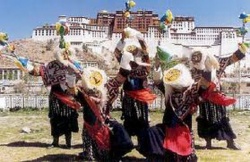Timeline of Tibet and Tibetan Buddhism
Revision as of 07:57, 18 June 2013 by Adminos (talk | contribs) (Created page with "thumb|250px| thumb|250px| Late 13th cent. October 1950 Late 1970s :4th cent. CE Vajrayana Buddhism develops in India. :7th ce...")
Late 13th cent. October 1950 Late 1970s
- 4th cent. CE Vajrayana Buddhism develops in India.
- 7th cent. Buddhism arrives in Tibet with the wives of King Songsten Gampo (c.609-650): Princess Wencheng from China and Princess Bhrikuti Devi from Napal. The king builds the Jokhang and Ramoché temples and makes Buddhism the state religion. Conflict with the former national religion, Bön, continues for centuries.
- c.775 King Trisong Detsen (c.755-797) of Tibet establishes a monastic community at Samyé based on Indian Mahayana Buddhism. The Tibetan Nyingma school is also formed in the eighth century.
- c.792-94 The Great Samyé Debate decides that Indian Mahayana Buddhism is the preferred form of Buddhism for Tibet.
- 836-42 King Langdarma (c.803-842) of Tibet persecutes Buddhists and supports Bön instead. All monasteries are destroyed and thousands of monks and lay people murdered.
- 1042 Atisa (c.982-1054), Indian monk and teacher (and former king), arrives in Tibet, where he inspires a renaissance of Buddhism.
- 1073 The Tibetan Sakya school is established by Khon Kongchog Gyalpo.
12th cent. The Kagyü school of Buddhism is established by Gampopa (1079-1153) in Tibet.
- Mid-12th cent. Buddhism in India is virtually extinct, leaving Tibet the center for Indian Mahayana Buddhism.
- 1253 The Mongolian leader Kublai Khan accepts Tibetan Buddhism, and it becomes the dominant religion of Mongolia.
Tibetan Buddhism expands into eastern and central Asia.
- 1409 The Geluk school of Buddhism is founded by Tsong Kha pa (1357-1419) with the establishment of Riwo Ganden monastery in Tibet.
- 1578 Sonam Gyatso (1543-88) is given the title of Dalai Lama by the Mongolian leader Altan Khan. He applies the honor to his two previous incarnations, thus making Gendun Drub (1391-1475) the "first" Dalai Lama.
- 1903 The Dalai Lama flees to China.
- 1904 Treaty between Britain and Tibet signed at Lhasa.
- 1906 Treaty between China and Britain (without Tibetan participation) recognizes China's suzerainty over Tibet.
- 1910 Dalai Lama flees to India
- 1912 After the Chinese Revolution, the Tibetans expel all the Chinese from Tibet and declare their independence from the new republic. Tibet functions as an independent government until 1951 and successfully defends its borders against China until 1931.
- 1950 Tenzin Gyatso (born 1935) becomes the fourteenth Dalai Lama.
China invades ("liberates") Tibet and suppresses Buddhism.
- 1951 A Tibetan delegation to China had to sign a treaty that professed to guarantee Tibetan autonomy and religion but also allowed the establishment of Chinese civil and military headquarters at Lhasa.
- March 1959 A popular rising at Lhasa is suppressed by China. The Dalai Lama escapes into India.
- 1963-71 No foreign visitor is allowed into Tibet.
Persecution of Tibetans abated with the end of the Cultural Revolution, but Chinese repression resumed when Tibetans renewed their claims to independence.
- early 1980s The Chinese government seeks diplomatic ties with the Dalai Lama and eases some restrictions in Tibet.
- 1988 China establishes martial law in Tibet after riots break out
- 1989 The Dalai Lama wins the Nobel Peace Prize.
- 1995 The Tibetan child Gedhun Choekyi Nyima is identified as the Panchen Lama. He is abducted by the Chinese authorities, who put another child on the monastic throne.
- 2000 Urgyen Thinley (born 1984), the seventeenth Gyalwa Karmapa, the head of the Kagyü school, escapes from Tibet to India.

